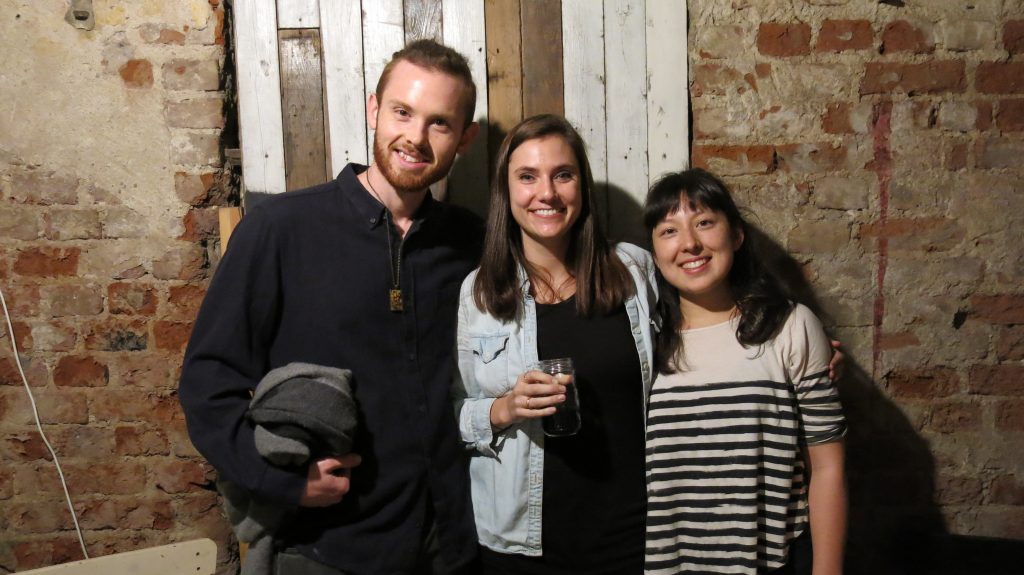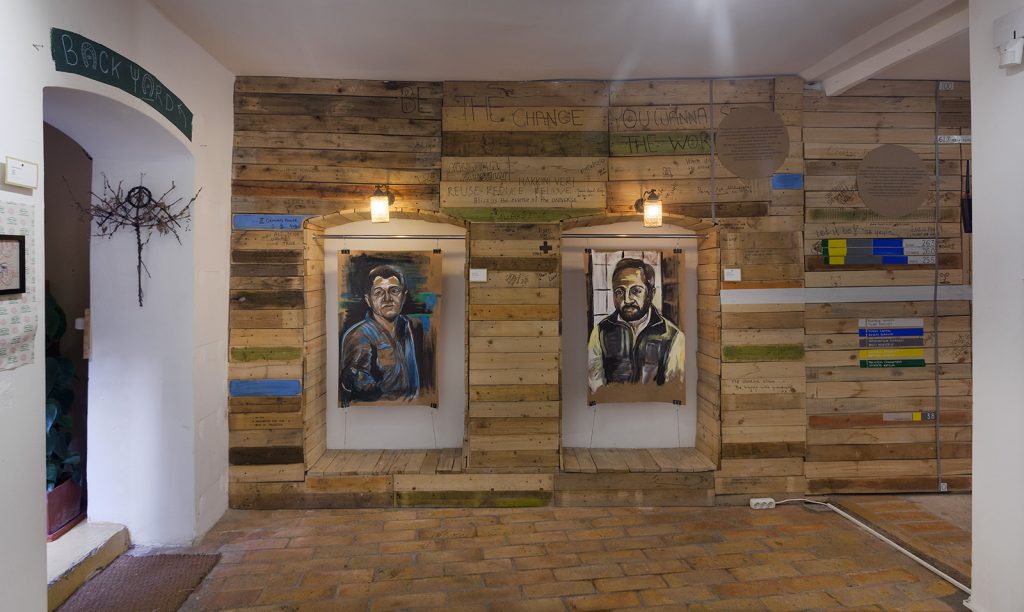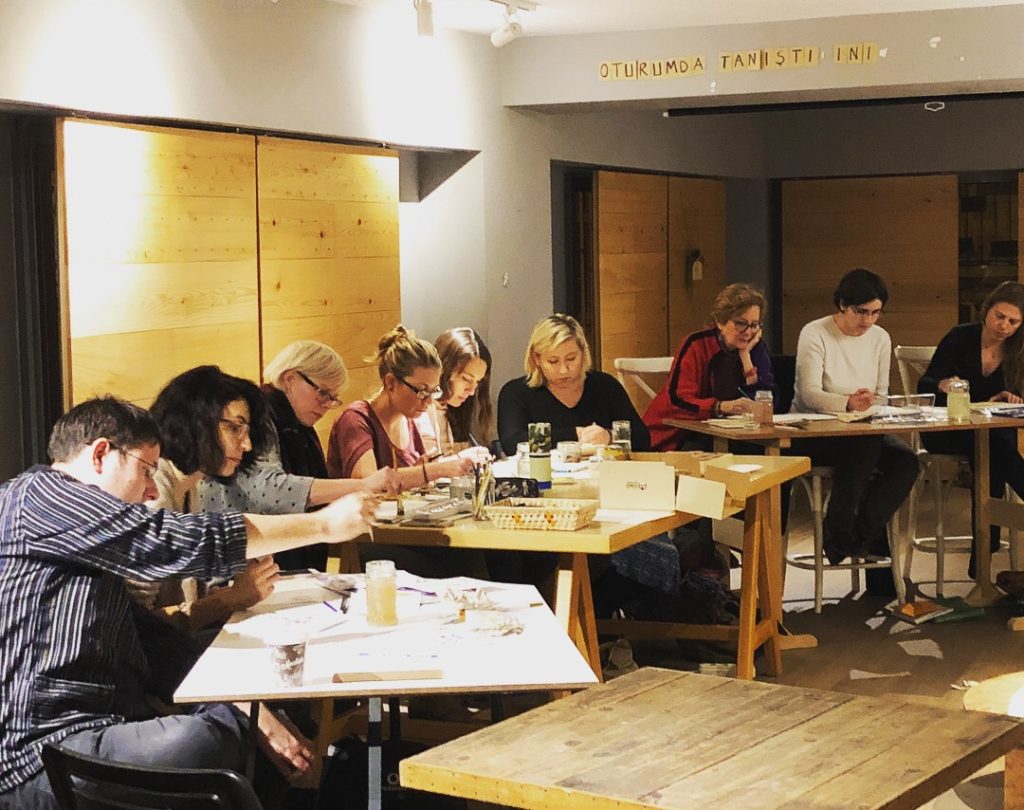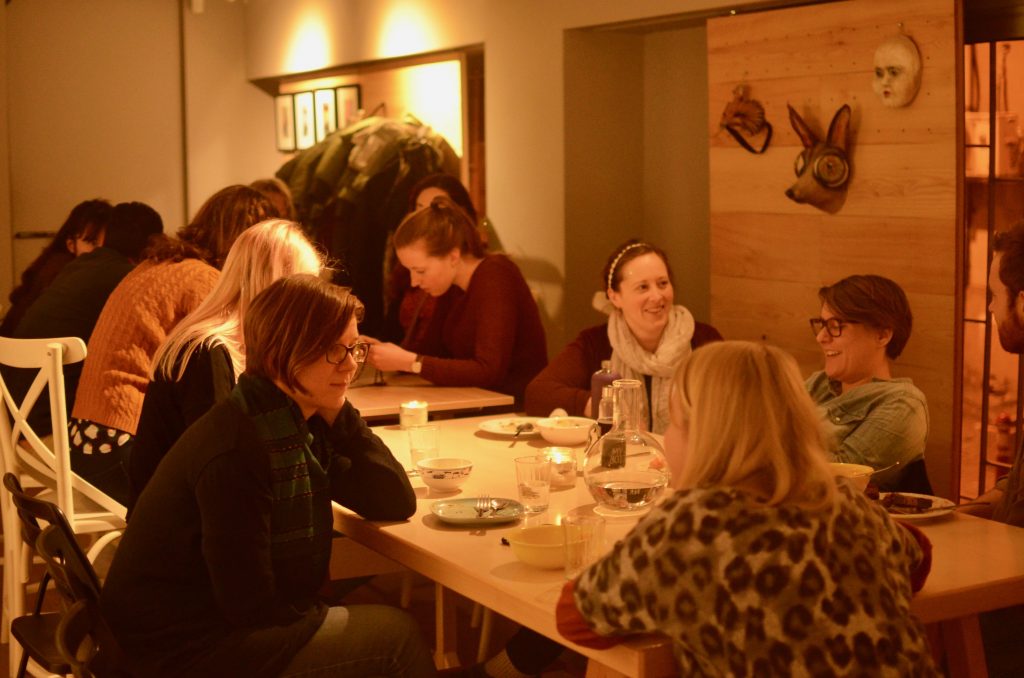On Tuesday evenings, people from all backgrounds and all over the city gather at a space called Circuit Istanbul in Kadıköy to enhance their creative skills under the supervision and support of Gabrielle “Gabby” Reeves, a painter from Wyoming living in Istanbul. The materials vary based on the week and range from watercolor to charcoal to pastel. Students have the option of bringing materials from home or paying a small additional fee to use materials provided by the space. Wooden movable surfaces attached to the walls display the artwork of past students. Trash is sorted into four crates: plastic, paper, other recyclables and organic waste. There is even a worm compost.

Gabby begins with a short introduction about artistic mediums and techniques, but just enough to stimulate creativity and provide new approaches without boring the students. As the students draw or paint, laughing and listening to soft acoustic music as they explore these new mediums, Gabby approaches each student and affectionately encourages them while still providing helpful suggestions to enhance the art. This spirit (along with reasonable prices) attracts both new and old students of all levels of artistic experience and accomplishment to come for art lessons.
The space, Circuit Istanbul, is a sanctuary for artistic development, physical and spiritual catharsis, and environmental awareness. For five years now, Circuit has been raising awareness about environmental sustainability and attracting people to it by facilitating art and yoga classes, community dinners, bazaars, workshops and other programs.
Environmentalism and sustainability are big buzz words nowadays. Many people are aware of the severity of climate change, but perplexed about what they can do about it, especially while confronting the realities of urban life. Circuit, now directed by passionate environmentalist Jessica “Jess” Sim, is one space helping people to initiate small changes that make a significant impact.
Along with organizing trash in this more ecologically scrupulous system, they are also encouraging alternatives to disposable packaging and one-time-usable vessels, demonstrating a creative approach to environmentalism. The place serves a shining, innovative example of the Buddhist principle that cultivating mindfulness on a personal level generates harmony on a global level.
For this interview, I sat down with both Gabby and Jess before art class one night to learn more about how they accomplish this.
How did Circuit Istanbul get started?
Jess: Circuit was founded by Ülkü Çağlayan in Çukurcuma in December 2013. It began as a lifestyle store and breath therapy center. In March 2015, myself and a friend, Olivia Traut came to Ülkü with the idea for the Museum of Garbage, which was an exhibition about waste in the city. She entrusted us with the space, which we transformed into a gallery for the exhibition. Following the Museum of Garbage, Paul Brownlee (who had assisted with the exhibition) and myself began to organize further events.
To start, our program consisted primarily of drawing classes (which alternated between life and beginner drawing) as well as a monthly collective, Tupperware dinner. Eventually we hosted our first holiday bazaar, along with Emma Harper, Chara Loka and Gabby. The bazaar included work from various artists and focused on sustainable gifts and packaging. The bazaar’s success was, in many ways, a turning point, convincing us to continue to build and grow the organisation. Paul and I directed Circuit between July 2015 until July 2017. Since then, I have continued to direct the organization on my own, along with an amazing team of people who support in project development, social media, classes and workshops.
Gabby: At the first holiday bazaar, we sold ceramics and prints. I made little handmade journals. We also had jewelry. Everything was handmade work for sale.
Jess: Since our first holiday bazaar we’ve continued hosting bazaars. Over time they have become more design-focused. In September 2016, we moved to the space we’re in now as the old space was to be repurposed by its owner. The new space has a lot more capacity, so we’re able to do a lot more. We now run weekly yoga classes and Tuesday art classes. On Wednesday, we host myotherapy classes; myotherapy is a movement technique that works with fascia and muscles to relieve aches and pains. We also host weekend workshops that focus on mindful living. The aim of all this is to build a creative community around more mindful living. Everything that we do is looking to inspire people to build tools to live more sustainably, and to become more aware of their relationships with themselves, with one another, and with their environments. So the main concern comes back to environmentalism and sustainability.
What other activities do you have in Circuit Istanbul?
Jess: We also host occasional art exhibitions and events. For example, we have an artist talk coming up on Friday, 16 March, with visiting artist Heidi Brandow, who will share her research on waste collectors in the city. This talk will be held in English. Under the leadership of Ülkü, we also continue to host bazaars once a season, featuring design-based products from sustainably minded brands.

What are some accomplishments that you’re proud of?
Gabby: For me, it was Şehir Ezmesi, which means “City Paste” This was an art exhibition that me, Jessica and Paul worked on. That was at the old space in Çukurcuma actually. This was in March of 2016 right before we moved to Kadıkoy. This exhibition was one of my biggest collaborations. It was a great way to use the space before it moved over here. We all made different work about change in Istanbul. We worked really close together, and it generated a lot of ideas and a lot of physical work from all of us. It also provided me with a lot of new ideas for me for future work.
Jess: The drawing classes and yoga classes are programs started out quite slow and needed consistency, but have now grown to have a nice following and community around them. Our general growth in programming and a better understanding of all the various ways we might reach our goals. There are so many ways to engage people with sustainability, and I feel like we’re just touching the surface. We’re proud of our growth so far and also hope to see more!
Gabby: Also, since the art classes have been going on for so long and so consistently every Tuesday, they have moved from something that was so new for both of us to something that has become so comfortable, rewarding and fun. We weren’t really sure what was going to happen, but we wanted to start it. Now, it’s become something I look forward to every week. It’s rewarding to see students that continue to come who were part of the drawing classes in Çukurcuma and also new students from the current neighborhood in Kadıköy, both foreign and Turkish. Every student shows great improvement with each class from their own hard work, and that is so wonderful to see.
Please describe your philosophy about environmentalism and sustainability.
Jess: Personally, my biggest concern is about climate change. I think there are many different ways to talk about this topic to build a community around it and to empower people to make simple changes in their lives. As an organization, we’re looking for ways that don’t necessarily address the issue directly, but that are more creative, roundabout and community-based.
On a functional level, we separate our waste, compost, and recyclables, and pay close attention to the use of materials. However our stronger intention is to inspire people, from all backgrounds, to engage with the idea of sustainability in their own way. For example, some people are more attracted to yoga classes and connecting with one’s self and one’s body, and with experiencing internal change. Some people are more attracted to collective dinners or community events and connecting to the people around them. Other people might prefer to come to a workshop about indoor planting and learn more practical skills about connecting to their environment. These are some of the ways we talk about environmentalism and sustainability.
Are there rules about the collective dinners?
Jess: People are welcome to bring whatever food they wish. People often bring vegetarian food, but that’s not a requirement. The requirement is that it comes in Tupperware or similar packaging. We’re very particular about our packaging and in general, the materials that are brought to and used at the space. For example, when hosting bazaars, we ask that there’s no plastic and all the packaging is either recyclable or paper. The same with an exhibition. We care a lot about the materials we use to hang an exhibition. This particular space is also designed for the idea that things can be put up and taken down without needing to repaint walls or make holes in the walls. The space was designed by GIG, which is the architecture company that we share the space with.

What are your process and goals in teaching art?
Gabby: When we grow up, we’re out of school, and we no longer have the opportunity to draw and create art in this kind of an environment, we often just leave it behind. I think a lot of people want to reconnect with their creativity, but are often scared because they feel like they don’t have the talent or ability, when rather its all about experiencing and practicing it.
I want everybody to know that drawing, painting, printmaking, and all processes that we do here can be learned and developed. It can grow with every individual. So I want to share the idea that art is for everyone, no matter if you haven’t drawn since you were in middle school or even if you’ve never drawn in your life. I think it’s a wonderful thing for everybody to learn to do. It’s a way for me to understand my environment more, to understand a place and understand people. It’s my way of figuring out the world. It’s a great exercise in awareness and mindfulness. I’m trying to bring all of that into our classes, no matter what material we are using.
Our classes are usually drawing based, with an emphasis on drawing from life. So that’s one of my main goals. It’s a lot easier for people to learn how to draw or paint by looking at a photograph. So I push students to really observe what they’re seeing in real time to show them how they can recreate that effect.
What are some future goals of the space?
Jess: After the summer, Circuit’s programs will be continued under a different name and carried to a different space. What we’re looking at now, is to put our roots somewhere a little more deep where we can have more programming throughout the day. Right now, a lot of our programs are in evenings and on weekends. We would like to expand this and create a space that is more open to the public during the day. We would like to continue building our ideas and alternative ways of facilitating a more sustainable community. We’re just starting to experiment with what that means. For example, we are looking to developing some alternative workshop structures.
We would also like to find more sustainable financial structures and human resource structures. Oftentimes, these types of organizations are directed by a few people who run a lot and then run out of energy. One of our major future goals is to develop an organization structure that is based more on permaculture design and biodiversity, sustaining all those involved. We have just started to look for our new space, but we will probably stay in the same area.
Gabby: My position here mostly has to do with art classes, artistic collaboration, and yoga classes. But I would say that we would like to continue to revisit a lot of lessons and ideas for new students. At the same time I would like to bring in new materials and new experiences. We won’t necessarily always stay in the space. We would like to take the classes outside of the as well, around the city. We would like to do more urban sketching and play around with different mediums.
We always try to introduce new classes and at the same time come back to the fundamentals so that new students coming in can also get a solid base in drawing and learn what we’re all about. Again, the focus of the drawing classes is always on sustainability. So we’re really conscious of the materials we use: where we buy them, the packaging they come in, what they’re made out of, how we use them, and how it affects the environment.

Is there anything else you want people to know about Circuit Istanbul?
Jess: At Circuit, our waste policy is very important to us. Anytime you come to the space, we ask that you be mindful about what you’re bringing. Please don’t bring plastic bottles, plastic bags, Styrofoam, disposable coffee cups (unfortunately, they are not recyclable) or other one-time-usables. We understand that it is not always possible to avoid such packaging, so we simply ask that you do your very best. Also, we are very open to collaboration or project ideas. We try to take all ideas into consideration. If they suit our programming and our direction, then we’re very happy to collaborate. Finally, do look out for news about the organization’s next steps!
For more information on Circuit’s programs, visit their official website or their Facebook page or instagram. Circuit Istanbul is located at Uzun Hafiz Sokak No: 39.
All photos courtesy of the author and the organizer.









